News
Do Poorer Schools Mean Poorer History Teaching?
A new study from the Department of Education suggests that students at the poorest schools were less likely to have a fully qualified history teacher at the head of their class.1

This study analyzes how many history teachers held one of two qualifications—a degree in the field (or at least a minor in history) and a certification to teach social studies. The report draws on a large survey of more than 51,000 school teachers in the 1999–2000 academic year, using the proportion of students receiving subsidized meals as a marker of relative poverty at the school.
According to the study, just 44.9 percent of students in America's high schools were taught by a teacher who had either majored or minored in history as undergraduate (only 37.4 percent by teachers who had majored in history). For students at schools where less than 10 percent of the student population received some subsidy for their lunches, more than 52 percent were taught history by a teacher with a major or minor in the field. In comparison, almost 46 percent of the students at schools where more than half of the students received subsidized meals learned their history from a teacher with that kind of sustained study in the discipline.
Similarly, while almost 90 percent of the students in history classes at the wealthiest schools had teachers with a certification in the social studies, barely 76 percent of students at the poorest schools had a teacher so certified. Among those teachers who lacked certification, a majority had a certification in another subject or specialty, with the largest portion qualified in special education (14.9 percent). At the poorest schools, however, more than half lacked any certification to teach.
Just 35 percent of the students at the poorest schools were in history classes where the teacher had at least a minor in the field and received certification to teach social studies. This was a third less than in the schools with the wealthiest student populations. Even in the wealthiest schools, however, fewer than half of the students (47.2 percent) were learning their history from teachers with both qualifications.
These are exceptionally broad criteria by which to judge the actual quality of the instruction these students are receiving. As the authors of the report note, "certification and postsecondary education are not the only routes through which teachers can gain subject matter expertise in the subjects they teach. Teachers may bring other professional and life experiences that provide them the subject matter grounding needed to teach effectively."
Nevertheless, to the extent these are generally recognized measures of teacher qualification, these findings suggest troubling variations in the quality of history instruction in the nation's schools.
—RBT
Note
1. Emily W. Holt and Daniel J. McGrath, Issue Brief: Qualifications of Public Secondary School History Teachers, 1999–2000 (Washington, D.C.: National Center for Education Statistics, 2006). Available online at http://nces.ed.gov/pubsearch/pubsinfo.asp?pubid=2006004. For a more comprehensive report on the results of the survey, see Marilyn McMillen Seastrom, et al., Qualifications of the Public School Teacher Workforce: Prevalence of Out-of-Field Teaching 1987–88 to 1999–2000. (Washington, D.C.: National Center for Education Statistics, 2004). Available online at http://nces.ed.gov/pubsearch/pubsinfo.asp?pubid=2002603.
Tags: Diversity, Equity, & Inclusion Teaching Resources and Strategies
Comment
Please read our commenting and letters policy before submitting.






